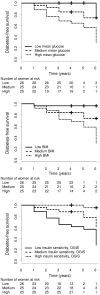Progression to type 2 diabetes in women with former gestational diabetes: time trajectories of metabolic parameters
- PMID: 23185618
- PMCID: PMC3503894
- DOI: 10.1371/journal.pone.0050419
Progression to type 2 diabetes in women with former gestational diabetes: time trajectories of metabolic parameters
Abstract
Aim of this study was analyzing the time trajectories of the metabolic parameters in European women with former gestational diabetes (fGDM), and determining predictors of type 2 diabetes onset. A group of seventy-six fGDM women were studied at the outpatient department of the University Clinic of Vienna. They were evaluated yearly with a 3 h-oral glucose tolerance test (OGTT) up to 7-years from delivery. At baseline, women also underwent an intravenous glucose tolerance test (IVGTT). Insulin sensitivity and beta-cell function were assessed by both OGTT and IVGTT. Women were divided into progressors (PROG) to diabetes (n = 19) and non-progressors (n = 57). Time trajectories of glycemia and other parameters were analyzed after synchronization to time of diabetes onset or last OGTT. Then, Cox proportional hazard regression analysis was performed to assess the predictive power of studied variables for diabetes onset. We found that, in PROG, time trajectories of glycemia were flat until diabetes onset, when they showed a marked increase (P<0.0001). Insulin sensitivity showed similar marked decrease (P<0.0001) at diabetes onset, together with a tendency to continuous slow decline in the previous years. At contrast, beta-cell function showed only continuous slow decline. Major predictors of diabetes onset were glycemic levels, BMI, insulin resistance, and condition of impaired glucose tolerance. In conclusion, in fGDM, marked deterioration of insulin sensitivity is associated with diabetes onset. Prevention strategies aimed at opposing to the insulin sensitivity derangement may be particularly beneficial.
Conflict of interest statement
Figures



References
-
- Kim C, Newton KM, Knopp RH (2002) Gestational diabetes and the incidence of Type 2 diabetes: a systematic review. Diabetes Care 25: 1862–1868. - PubMed
-
- Kjos SL, Buchanan TA, Greenspoon JS, Montoro M, Bernstein GS, et al. (1990) Gestational diabetes mellitus: the prevalence of glucose intolerance and diabetes mellitus in the first two months postpartum. Am J Obstet Gynecol 163: 93–98. - PubMed
-
- Lam KS, Li DF, Lauder IJ, Lee CP, Kung AW, et al. (1991) Prediction of persistent carbohydrate intolerance in patients with gestational diabetes. Diabetes Res Clin Pract 12: 181–186. - PubMed
-
- Catalano PM, Vargo KM, Bernstein IM, Amini SB (1991) Incidence and risk factors associated with abnormal postpartum glucose tolerance in women with gestational diabetes. Am J Obstet Gynecol 165: 914–919. - PubMed
-
- Kjos SL, Peters RK, Xiang A, Henry OA, Montoso M, et al. (1995) Predicting future diabetes in Latino women with gestational diabetes. Utility of early postpartum glucose tolerance testing. Diabetes 44: 586–591. - PubMed
Publication types
MeSH terms
Substances
LinkOut - more resources
Full Text Sources
Medical

